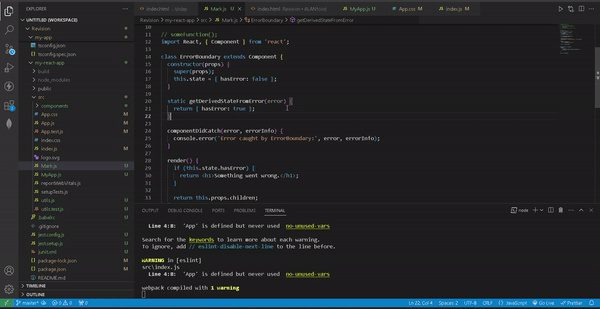Difference between Error Boundaries & try-catch in React
Last Updated :
01 Apr, 2024
“Error handling is an essential aspect of software development” to ensure that applications handle unexpected situations gracefully.” Error boundaries and try-catch are both mechanisms used in JavaScript for error handling, but they serve different purposes and use cases. Understanding when to use error boundaries and when to use try-catch is essential for effective error handling in your applications.
Both techniques catch and handle errors, but they differ in their application and use cases.
What are Error Boundaries ?
Definition: Error boundaries are components in React that catch JavaScript errors anywhere in their child component tree, log those errors, and display fallback UI instead of crashing the whole application. They are used to gracefully handle errors that occur during rendering, in lifecycle methods, and constructors of the whole component tree below them.
Features of Error Boundaries :
- Error boundaries work only in React applications.
- They catch errors during rendering, in lifecycle methods, and constructors of the whole component tree below them.
- They help prevent entire React applications from crashing due to errors in individual components.
- Error boundaries work asynchronously during rendering, so they don’t catch errors inside event handlers or asynchronous code.
- Error boundaries can be used to log errors and display fallback UI to the user.
Example:
JavaScript
import React, { Component } from 'react';
class ErrorBoundary extends Component {
constructor(props) {
super(props);
this.state = { hasError: false };
}
static getDerivedStateFromError(error) {
return { hasError: true };
}
componentDidCatch(error, errorInfo) {
console.error('Error caught by ErrorBoundary:', error, errorInfo);
}
render() {
if (this.state.hasError) {
return <h1>Something went wrong.</h1>;
}
return this.props.children;
}
}
class MyComponent extends Component {
render() {
return (
<ErrorBoundary>
<div>This is a component protected by ErrorBoundary.</div>
</ErrorBoundary>
);
}
}
export default MyComponent;
Output: If an error occurs within the ErrorBoundary, it will catch the error and display “Something went wrong.” Otherwise, it will render the component normally.

Error Boundaries Sample Output GIF
What is Try-Catch ?
Try-catch is a JavaScript construct used for handling synchronous errors. It allows you to catch errors that occur within a specific block of code and handle them gracefully without crashing the entire application.
It consists of two main parts: the try block, where code that might throw an error is placed, and the catch block, where error handling logic is written to handle any exceptions thrown by the try block.
Features of try-catch:
- try-catch can be used in any JavaScript code, not limited to React applications.
- It catches errors only within the block of code wrapped in the try statement.
- It provides a mechanism to gracefully handle errors without crashing the entire application.They provide a mechanism for developers to gracefully handle errors and execute fallback logic.
- It catches errors synchronously at runtime.
- It can be used to catch errors in any JavaScript code, including asynchronous code.
Example:
JavaScript
function divide(x, y) {
try {
if (y === 0) {
throw new Error("Division by zero is not allowed.");
}
return x / y;
} catch (error) {
console.error("Error occurred:", error.message);
}
}
console.log(divide(10, 2)); // Output: 5
console.log(divide(10, 0)); // Output: Error occurred: Division by zero is not allowed.
Difference between Error Boundaries & try-catch:
Feature
| Error Boundaries
| Try-Catch
|
|---|
Application
| Limited to React applications
| Applicable to any JavaScript code
|
Scope
| Catches errors in component tree below them
| Catches errors within a specific block of code
|
Use Cases
| Used in React components to prevent crashes
| Used in imperative JavaScript code to handle errors
|
Asynchronous
| Yes
| No
|
Crash Prevention
| Yes
| No (only for synchronous errors)
|
Granularity
| Catches errors at component level
| Catches errors at a specific block level
|
Fallback UI
| Can display fallback UI
| Does not display UI, only executes logic
|
Error Information
| Provides component stack trace
| Provides error message and stack trace
|
When to Use which Approach ?
Error Boundaries:
- When you want to handle errors for an entire subtree of components.
- When you want to display a fallback UI when an error occurs in a component tree.
try-catch:
- When you want to handle errors in a specific block of code.
- When you want to catch synchronous errors within a component’s methods.
- Choose the approach based on the context and requirements of your application.
Share your thoughts in the comments
Please Login to comment...